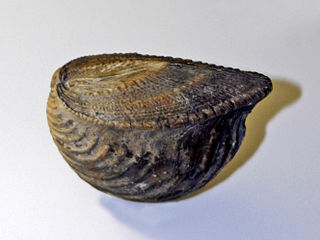
Angophora is a genus of flowering plants in the myrtle family, Myrtaceae, described as a genus in 1797. It is endemic to Australia, where species are distributed in Queensland, New South Wales, and Victoria. The centre of diversity is along the northern and central coast of New South Wales.
Hygrophila costata, with the common names glush weed, gulf swampweed, and yerba de hicotea, is an aquatic plant

Angophora costata is a common woodland and forest tree of Eastern Australia, and is known by a variety of names including smooth-barked apple, rose gum, rose apple and Sydney red gum. It grows primarily on sandstone soils, usually on headlands, plateaus or other elevated areas. A. costata differs from the majority of "gum trees" in that it is not a true Eucalyptus, but rather a closely related genus. Unlike the majority of eucalypts, whose adult leaves are arranged in an alternate pattern along the stem, angophora leaves are positioned opposite each other. A. costata is a large, wide and spreading tree, usually of a height between 15m and 25m. The trunk is often gnarled and crooked with a pink to pale grey, sometimes rusty-stained bark. In nature, the butts of broken limbs form callused bumps on the trunk and add to the gnarled appearance. The old bark is shed in spring in large flakes with the new salmon-pink bark turning pale grey before the next shedding.

Pouteria costata is a small coastal tree native to the northern North Island and to Norfolk Island (Australia). In New Zealand, its common name is tawapou ; on Norfolk Island it is called bastard ironwood. The name costata is from the Latin costatus (ribbed), a reference to the prominently raised primary nerves of the leaves. Pouteria is a genus of approximately 300 species in the tropics of America, Asia, Australia and the Pacific. A Pouteria species found in other Pacific Islands is sometimes erroneously included in P. costata.
Namibcypris costata is an extinct species of ostracod crustaceans in the family Candonidae, possibly endemic to the southern Kaokoveld in northern Namibia.

Anisoptera costata is an endangered species of plant in the family Dipterocarpaceae. The name costata is derived from Latin and describes the prominent venation of the leaf blade. A huge emergent tree up to 65 m high, it is found in evergreen and semi-evergreen lowland tropical seasonal forests of Indo-Burma and in mixed dipterocarp forests of Malesia.
Utricularia costata is a small, probably annual carnivorous plant that belongs to the genus Utricularia. U. costata is endemic to Brazil and Venezuela. It grows as a terrestrial or lithophytic plant in damp soils among rocks in savannas. It was originally described and published by Peter Taylor in 1986.
Euodia is a plant genus in the Rutaceae family. Euodia is sometimes misspelled as Evodia. The species now included in the genus Tetradium were previously included in Euodia, and may be commonly referred to as euodia.
Apocera is a genus of snout moths. It was described by William Schaus in 1912.

Cyrtopleura costata, or the angel wing clam, is a bivalve mollusc in the family Pholadidae. It is found in shallow parts of the northwest Atlantic and also in the North Sea of Scotland coastline and west coast of the Adriatic Sea by a remote area in the Marche region in central Italy, living in the seabed, where it digs its burrows on a very slow revolving movement for years through soft sand and mud stone always to a max depth of 8ft but always below 3 feet (0.91 m) at the lowest tide.

Composita is a brachiopod genus that lived from the Late Devonian to the Late Permian. Composita had a smooth shell with a more or less distinct fold and sulcus and a round opening for the pedicle on the pedicle valve. Composita is included in the family Athyrididae and placed in the subfamily Spirigerellinae.

Angophora leiocarpa is a tree species that is native to eastern Australia. It grows to 25 metres in height and has smooth grey to cream bark that sheds in small patches revealing pink underneath. Its range extends northwards from Grafton in New South Wales to Queensland.

Trigonia is an extinct genus of saltwater clams, fossil marine bivalve mollusk in the family Trigoniidae. The fossil range of the genus spans the Paleozoic, Mesozoic and Paleocene of the Cenozoic, from 298 to 56 Ma.
Crossotini is a tribe of longhorn beetles of the Lamiinae subfamily. It was described by Thomson in 1864.
Nyoma costata is a species of beetle in the family Cerambycidae. It was described by Breuning in 1949.

Hakea costata, commonly known as the ribbed hakea, is a shrub in the Proteaceae family native to Western Australia. A multi-stemmed small shrub producing attractive pink or white brush-like blooms rich in nectar from July to October.
Castanopsis costata is a tree in the beech family Fagaceae. The specific epithet costata is from the Latin meaning "ribbed", referring to the leaf venation.
Penthea costata is a species of beetle in the family Cerambycidae. It was described by Francis Polkinghorne Pascoe in 1863. It is known from Australia.
Mallosia costata is a species of beetle in the family Cerambycidae. It was described by Maurice Pic in 1898. It is known from Turkey and Iran.
Cyathochitina is an extinct genus of chitinozoans. It was described by Alfred Eisenack in 1955.











